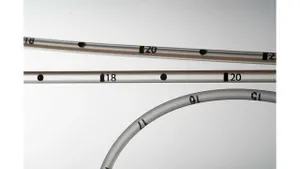Why Medtronic scored gold in the DuPont packaging innovation awards
Medical device manufacturer Medtronic (Dublin) was one of five companies to receive a gold award at last week's 2015 DuPont Awards for Packaging Innovation. The EnVeo R packaging for its transcatheter aortic valve replacement (TAVR) device represents a truly novel approach that replaces a two-pouch system with a single pouch, enabling one person to perform what used to require two medical personnel. Medtronic shared with PlasticsToday the evolution of this design and the material selection and thermoforming challenges it entailed.
May 18, 2015
TAVR is a relatively new surgical procedure that repairs damaged heart valves by wedging a replacement valve into the aortic valve using minimally invasive techniques. It's somewhat similar to placing a stent in an artery, explains the American Heart Association. The procedure is approved by FDA for patients who are considered high risk for standard, open-heart valve replacement surgery. The CE-marked Enveo R system has been available in Europe and several other countries since September 2014. It is currently undergoing clinical trials in the United States.

The precursor packaging, which is used with Medtronic's CoreValve system, consists of two pouches. The valve does not come pre-loaded on the catheter and must be assembled in the cath lab prior to implantation. Historically this loading process required significant resources to complete, explains Medtronic in the submission form for the packaging innovation awards program. The valve was required to be rinsed in three separate saline baths, provided by the hospital, in a timed sequence prior to loading. A fourth bath filled with saline was then required to load the valve onto the catheter—this task has to be completed with the valve and catheter fully submerged under saline. Two operators were required to perform this task: One to control catheter handle actuation and the other to manage the valve as it was reduced in diameter and fed into the distal end of the delivery catheter.
By observing how healthcare workers used the product in the field and asking them for feedback, Medtronic engineers developed a novel packaging design that streamlines the catheter loading process, such that it now takes one operator to perform the task rather than two, representing a significant improvement in allocation of resources in the cath lab.
The single-pouch configuration required a new material—a nylon-based film laminate (20/20/50; nylon/nylon/polyethylene)—that was custom developed to meet medical device packaging requirements. Using a single pouch as the sterile barrier system resulted in a material savings of 118 grams.
Eastman's Tritan material was selected for the thermoformed tray to satisfy strength, flexibility, biocompatibility and performance requirements, says Medtronic. Maintaining tight tolerances, especially in the snap-fit locations, was a significant challenge, which the company described in the submission form: The snap fits in the tray had to be precisely controlled in terms of their geometry and thickness, because variation would result in the snap fits being too tight (very difficult to assemble and extremely difficult to disassemble by the end user) or too loose (i.e., the tray components would not withstand the rigors of distribution and handling). This required creative thermoforming tooling, process controls and design changes which was accomplished by leveraging the technology know how of supplier partners. (The packaging innovation awards named Medtronic and Prent Corp. as joint recipients).
Package design represented a separate challenge, as the catheter must be packaged in a straight configuration for the product's entire life cycle but is bent 180° during the loading process. To satisfy these requirements while incorporating user-friendly features, the tray is designed with a dual configuration that incorporates a locking mechanism.
The packaging maintains its straight configuration during transport and then transforms into the 180° configuration during valve loading. All of this is achieved while keeping the catheter in situ, since the packaging incorporates baths that previously were provided by the hospitals. The integration of a valve loading bath into the tray also meant that the catheter could remain securely in place in the tray. The three rinsing baths sit securely within the loading bath of the main tray. The rinsing baths are inverted, and a channel and clip were added to allow the catheter to be secured in the straight configuration. The rinsing baths can then be removed in the sterile field, inverted and used to rinse the valve in a saline solution. The clip, which is located at the base of the rinsing baths, is used to secure the catheter in a lower position in the tray.
While observing medical personnel in the field, design engineers identified visualization of the valve attachment points during catheter loading as a key requirement. A second requirement was keeping the valve submerged under saline during this process.
To overcome this challenge, a reflective film strip (or mirror label) was added to the base of the tray, which allows 360° visualization of the valve and all attachment points. This was a breakthrough, says Medtronic, because visualization is difficult in dimly lit cath labs, and the mirror label gives users confidence that the valve has been correctly loaded on the delivery catheter. The reflective strip on the base of the loading bath helps the operator verify that the valve is securely attached to the catheter without having to lift the partially loaded valve out of the bath.
The novel packaging design resulted in a 50% reduction in human resources, since one person is able to perform the task instead of two, and accelerated the loading procedure by an average of four minutes. Improving productivity without sacrificing safety or performance is always beneficial; in the operating room, where lives may hang in the balance, it is critical.
Check out the other winners of the 2015 DuPont Awards for Packaging Innovation in this slide show.
About the Author(s)
You May Also Like




